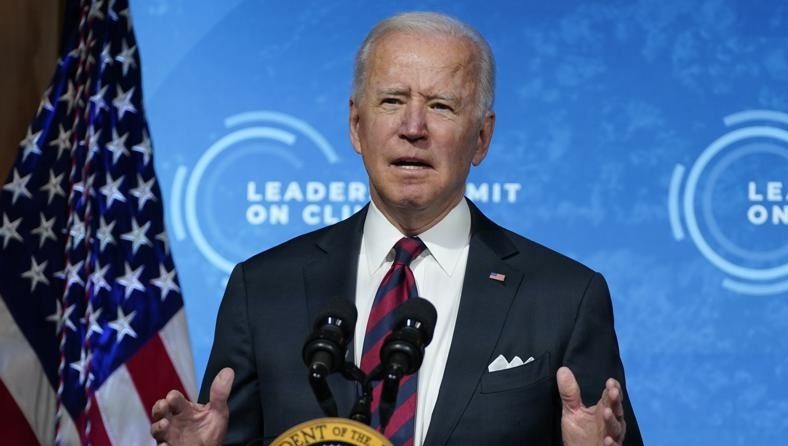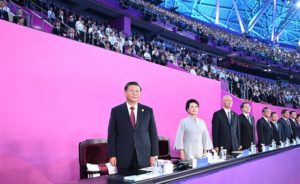Climate summit : China, Russia join US vowing emission cuts

Washington (AP) — President Joe Biden convened leaders of the world’s most powerful countries on Thursday ( April 22 ) to try to spur global efforts against climate change, drawing commitments from Chinese President Xi Jinping and Russian President Vladimir Putin to cooperate on cutting emissions despite their own sharp rivalries with the United States.
“Meeting this moment is about more than preserving our planet,” Biden declared, speaking from a TV-style set for a virtual summit of 40 world leaders. “It’s about providing a better future for all of us,” he said, calling it “a moment of peril but a moment of opportunity.”
“The signs are unmistakable. the science is undeniable. the cost of inaction keeps mounting,” he added.
Biden’s own new commitment, timed to the summit, is to cut U.S. fossil fuel emissions up to 52% by 2030, marking a return by the U.S. to global climate efforts after four years of withdrawal under President Donald Trump.
Biden’s administration is sketching out a vision of a prosperous, clean-energy United States where factories churn out cutting-edge batteries for export, line workers re-lay an efficient national electrical grid and crews cap abandoned oil and gas rigs and coal mines.
Japan, a heavy user of coal, announced its own new 46% emissions reduction target Thursday as the U.S. and its allies sought to build momentum through the summit.
South Korea used the summit to say it would stop all public financing of new coal-fired power plants, an important step that climate groups hope will help persuade China and Japan to slow their own building and funding of coal power.
The coronavirus pandemic compelled the summit to play out as a climate telethon-style livestream, limiting opportunities for spontaneous interaction and negotiation. The opening was rife with small technological glitches, including echoes, random beeps and off-screen voices.
But the U.S. summit also marshaled an impressive display of the world’s most powerful leaders speaking on the single cause of climate change.
China’s Xi, whose country is the world’s biggest emissions culprit, followed by the United States, spoke first among the other global figures. He made no reference to nonclimate disputes that had made it uncertain until Wednesday that he would even take part in the U.S. summit, and said China would work with America in cutting emissions.
“To protect the environment is to protect productivity, and to boost the environment is to boost productivity. It’s as simple as that,” Xi said.
Putin, whose government has been publicly irate over Biden’s characterization of him as a “killer” for Russia’s aggressive moves against its opponents, made no mention of his feuding with Biden in his own climate remarks, a live presentation that also saw moments of dead air among production problems.
“Russia is genuinely interested in galvanizing international cooperation so as to look further for effective solutions to climate change as well as to all other vital challenges,” Putin said. Russia by some measures is the world’s fourth-biggest emitter of climate-damaging fossil fuel fumes.
The pandemic made gathering world leaders for the climate summit too risky. That didn’t keep the White House from sparing no effort on production quality. The president’s staff built a small set in the East Room that looked like it was ripped from a daytime talk show.
Biden and Vice President Kamala Harris addressed the summit from separate lecterns before joining Secretary of State Anthony Blinken and White House climate envoy John Kerry at a horseshoe-shaped table set up around a giant potted plant to watch fellow leaders’ livestreamed speeches.
The format meant a cavalcade of short speeches by world leaders, some scripted, some apparently more impromptu. “This is not bunny-hugging,” British Prime Minister Boris Johnson said of the climate efforts. “This is about growth and jobs.”
The Biden administration’s pledge would require by far the most ambitious U.S. climate effort ever, nearly doubling the reductions that the Obama administration had committed to in the landmark 2015 Paris climate accord.
German Chancellor Angela Merkel was one of many allies welcoming the U.S. back into the accord after Trump pulled out, boosted oil and gas production and mocked the science underlying climate warnings.
“I’m delighted to see that the United States is back, is back to work together with us in climate politics,” Merkel declared in her virtual appearance. “Because there can be no doubt about the world needing your contribution if we really want to fulfill our ambitious goals.”
The new urgency comes as scientists say that climate change caused by coal plants, car engines and other fossil fuel use is worsening droughts, floods, hurricanes, wildfires and other disasters and that humans are running out of time to stave off catastrophic extremes of global warming.
Leaders of smaller states and island nations buffeted by rising seas and worsening hurricanes appealed for aid and fast emissions cuts from world powers.
“We are the least contributors to greenhouse gas emissions, but the most affected by climate change,” said Gaston Alfonso Browne, prime minister of Antigua and Barbuda. He called for debt relief and more international assistance to recover from storms and the pandemic to prevent a flow of climate refugees.
But U.S. officials, in previewing the new administration target, disclosed aspirations and vignettes rather than specific plans, budget lines or legislative proposals for getting there.
Biden excused himself in the midst of the first session for other duties, but planned to join a second session on financing poorer countries’ efforts to remake and protect their economies against global warming.
With the pledge from the United States and other emissions-cutting announcements from Japan, Canada, the European Union and the United Kingdom, countries representing more than half the world’s economy have now committed to cutting fossil fuel fumes enough to keep the earth’s climate from warming, disastrously, more than 2.7 degrees Fahrenheit (1.5 degrees Celsius), the U.S. administration said.
As of 2019, before the pandemic, the U.S. had reduced 13% of its greenhouse gases compared with 2005 levels, which is about halfway to the Obama administration goals of 26% to 28%, said climate scientist Niklas Hohne of Climate Action Tracker. That’s owing largely to market forces that have made solar and wind, and natural gas, much cheaper
Biden, a Democrat, campaigned partly on a pledge to confront climate change. He has sketched out some elements of his $2 trillion approach for transforming U.S. transportation systems and electrical grids in his campaign climate plan and in his infrastructure proposals for Congress.
His administration insists the transformation will mean millions of well-paying jobs. Republicans say the effort will throw oil, gas and coal workers off the job. They call his infrastructure proposal too costly.
“The summit is not necessarily about everyone else bringing something new to the table — it’s really about the U.S. bringing their target to the world,” said Joanna Lewis, an expert in China energy and environment at Georgetown University.
Political divisions in America that were exposed by Trump’s presidency have left the nation weaker in the climate-change fight than it was at the 2015 Paris accord. Unable to guarantee that a different president in 2024 won’t undo Biden’s work, the administration has argued that market forces — with a boost to get started — will soon make cleaner fuels and energy efficiency too cheap and consumer-friendly to trash.
Photo : President Joe Biden speaks to the virtual Leaders Summit on Climate, from the East Room of the White House, April 22, 2021, in Washington. (AP Photo/Evan Vucci)
22 April 2021










